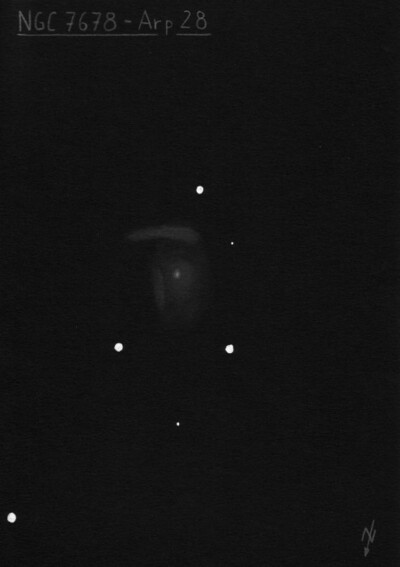
William Herschel discovered NGC 7678 = H II-226 = h2245 on 15 Sep 1784 (sweep 274) and recorded "F, pL, bM, elliptical, between an acute triangle of pretty considerable stars." On sweep 91, JH described this object as "F; vR [sic?]; pL; lbM; very symmetrically situated in the southern part of a lozenge of 4 stars, on the longer diagonal, forming an elegant object." He included a sketch in the Slough catalogue (fig. 85).
On 5 Nov 1850, Lord Rosse's assistant George Johnstone Stoney reported "I saw two knots and a dark space between them [gap between nucleus and southern arm]. I think the nebula is connected above the dark space." R.J. Mitchell, observing in 1854, noted "spirality distinctly seen. I thought the coil double in more closely upon itself than shown in Mr. Stoney's drawing, and that the central knot had a stellar nucleus. The whole nebula looked sparkling, though I could not see any separate stars."
300/350mm - 13.1" (9/9/83): faint, moderately large, diffuse, slightly elongated ~N-S, 1.8'x1.4', weak concentration. Located within a thin isosceles triangle of mag 10.5-11 stars with the vertex at the south end and height 2.5'. The mag 11 star just off the south end is just 1.1' from the center.
600/800mm - 24" (10/5/13): NGC 7678 is in the Arp group of "spiral galaxies - one heavy arm", which is evident visually. At 260x the galaxy is beautifully framed with a thin triangle of mag 11.3/11.4 stars to the north and a mag 12 star off the south end. It appeared fairly bright, moderately large, elongated SW-NE, ~1.8'x1.3'. Contains a brighter elongated core that increases to a very small brighter nucleus. The "heavy arm" is visible on the south side as a thin, shallow arc in the outer halo and brightens right at its western tip.
900/1200mm - 48" (10/27/16 and 10/28/19): at 610x; very bright, fairly large, slightly elongated SSW-NNE, 2.0'x1.5'. Contains and small bright core and an extremely bright, very small nucleus with a pinpoint stellar peak. The core is elongated WNW-ESE and appeared as a weak bar. A bright thin arm was nearly attached on the east side of the "bar" and swung counterclockwise to the south of the core. This arm was sharply defined and brightened significantly on the southwest end [~30" SW of center]. The northern arm was only visible at its root near the west end of the "bar" as well as a small, detached piece on the northeast side of the halo [30" NE of center]. The galaxy sits within a bright isosceles triangle of mag 11/12 stars. The observation was made in good seeing but through thin clouds.
Notes by Steve Gottlieb